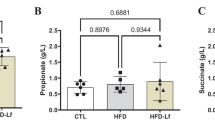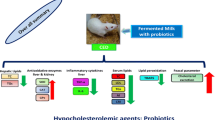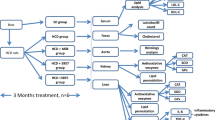Abstract
Metabolic syndrome, encompassing type 2 diabetes mellitus and cardiovascular disease, is a growing health concern of industrialized countries. Ferulic acid (FA) is a phenolic acid found in foods normally consumed by humans that has demonstrated antioxidant activity, cholesterol-lowering capabilities, and anti-tumorigenic properties. Select probiotic bacteria, including Lactobacillus fermentum NCIMB 5221, produce FA due to intrinsic ferulic acid esterase activity. The aim of the present research was to investigate a FA-producing probiotic, L. fermentum NCIMB 5221, as a biotherapeutic for metabolic syndrome. The probiotic formulation was administered daily for 8 weeks to Zucker diabetic fatty (ZDF) rats, a model of hyperlipidemia and hyperglycemia. Results show that the probiotic formulation reduced fasting insulin levels and insulin resistance, significantly reduced serum triglycerides (p = 0.016), lowered serum low-density lipoprotein cholesterol levels (p = 0.008), and significantly reduced the atherogenic (p = 0.016) and atherosclerosis (p = 0.012) index as compared to the control animals. In addition, the probiotic formulation significantly increased high-density lipoprotein cholesterol levels (p = 0.041) as compared to the control animals. This research indicates that administration of the FA-producing L. fermentum NCIMB 5221 has the potential to reduce insulin resistance, hyperinsulinemia, hypercholesterolemia, and other markers involved in the pathogenesis of metabolic syndrome. Further studies are required to investigate the human clinical potential of the probiotic formulation in affecting the markers and pathogenesis of metabolic syndrome.






Similar content being viewed by others
References
Adisakwattana S, Moonsan P, Yibchok-anun S (2008) Insulin-releasing properties of a series of cinnamic acid derivatives in vitro and in vivo. J Agric Food Chem 56:7838–7844
Ahmadi SA, Boroumand MA, Gohari-Moghaddam K, Tajik P, Dibaj SM (2008) The impact of low serum triglyceride on LDL-cholesterol estimation. Arch Iran Med 11:318–321
Balasubashini MS, Rukkumani R, Viswanathan P, Menon VP (2004) Ferulic acid alleviates lipid peroxidation in diabetic rats. Phytotherapy Research 18:310–314
Bhathena J, Kulamarva A, Urbanska AM, Martoni C, Prakash S (2007) Microencapsulated bacterial cells can be used to produce the enzyme feruloyl esterase: preparation and in-vitro analysis. Appl Microbiol Biotechnol 75:1023–1029
Bhathena J, Kulamarva A, Martoni C, Urbanska AM, Prakash S (2008) Preparation and in vitro analysis of microencapsulated live Lactobacillus fermentum 11976 for augmentation of feruloyl esterase in the gastrointestinal tract. Biotechnol Appl Biochem 50:1–9
Bhathena J, Martoni C, Kulamarva A, Urbanska AM, Malhotra M, Prakash S (2009) Orally delivered microencapsulated live probiotic formulation lowers serum lipids in hypercholesterolemic hamsters. J Med Food 12:310–319
Bhathena J, Tomaro-Duchesneau C, Martoni C, Malhotra M, Kulamarva A, Urbanska AM, Paul A, Prakash S (2012) Effect of orally administered microencapsulated FA-producing L. fermentum on markers of metabolic syndrome: an in vivo analysis. J Diabetes Metab S2:
Bhathena J, Martoni C, Kulamarva A, Tomaro-Duchesneau C, Malhotra M, Paul A, Urbanska AM, Prakash S (2013) Oral probiotic microcapsule formulation ameliorates non-alcoholic fatty liver disease in Bio F1B Golden Syrian hamsters. PLoS ONE 8:e58394
Bogsan CSB, Florence ACR, Perina N, Barbuti RC, Navarro-Rodriguez T, Eisig JN, Oliveira MN (2011) Probiotics intake and metabolic syndrome: a proposal. Trends Food Sci Technol 22:457–464
Dobiasova M (2004) Atherogenic index of plasma [log(triglycerides/HDL-cholesterol)]: theoretical and practical implications. Clin Chem 50:1113–1115
Donath MY, Shoelson SE (2011) Type 2 diabetes as an inflammatory disease. Nat Rev Immunol 11:98–107
FAO (2001) Health and nutritional properties of probiotics in food including powder milk with live lactic acid bacteria. WHO, London
Ford ES, Giles WH, Dietz WH (2002) Prevalence of the metabolic syndrome among US adults: findings from the Third National Health and Nutrition Examination Survey. JAMA 287:356–359
Ford ES, Mokdad AH, Giles WH, Brown DW (2003) The metabolic syndrome and antioxidant concentrations: findings from the Third National Health and Nutrition Examination Survey. Diabetes 52:2346–2352
Gabbay KH, Hasty K, Breslow JL, Ellison RC, Bunn HF, Gallop PM (1977) Glycosylated hemoglobins and long-term blood glucose control in diabetes mellitus. The Journal of Clinical Endocrinology & Metabolism 44:859–864
Grundy SM (2011) The metabolic syndrome. Atlas of Atherosclerosis and Metabolic Syndrome 1–26
Grundy SM, Cleeman JI, Daniels SR, Donato KA, Eckel RH, Franklin BA, Gordon DJ, Krauss RM, Savage PJ, Smith SC, Spertus JA, Costa F (2005) Diagnosis and management of the metabolic syndrome. Circulation 112:2735–2752
Hu CT, Wu JR, Cheng CC, Wang S, Wang HT, Lee MC, Wang LJ, Pan SM, Chang TY, Wu WS (2011) Reactive oxygen species-mediated PKC and integrin signaling promotes tumor progression of human hepatoma HepG2. Clinical and Experimental Metastasis 28:851–863
Ishii N, Fujii M, Hartman PS, Tsuda M, Yasuda K, Senoo-Matsuda N, Yanase S, Ayusawa D, Suzuki K (1998) A mutation in succinate dehydrogenase cytochrome b causes oxidative stress and ageing in nematodes. Nature 394:694–697
Isolauri E, Kirjavainen PV, Salminen S (2002) Probiotics: a role in the treatment of intestinal infection and inflammation? Gut 50:iii54–iii59
Jones ML, Martoni CJ, Parent M, Prakash S (2012) Cholesterol-lowering efficacy of a microencapsulated bile salt hydrolase-active Lactobacillus reuteri NCIMB 30242 yoghurt formulation in hypercholesterolaemic adults. Br J Nutr 107:1505–1513
Jones ML, Tomaro-Duchesneau C, Martoni CJ, Prakash S (2013) Cholesterol lowering with bile salt hydrolase-active probiotic bacteria, mechanism of action, clinical evidence, and future direction for heart health applications. Expert Opinion on Biological Therapy 13:631–642
Kissebah AH, Alfarsi S, Adams PW, Wynn V (1976) Role of insulin resistance in adipose tissue and liver in the pathogenesis of endogenous hypertriglyceridaemia in man. Diabetologia 12:563–571
Lai KK, Lorca GL, Gonzalez CF (2009) Biochemical properties of two cinnamoyl esterases purified from a Lactobacillus johnsonii strain isolated from stool samples of diabetes-resistant rats. Appl Environ Microbiol 75:5018–5024
Lebovitz HE (2011) Type 2 diabetes mellitus—current therapies and the emergence of surgical options. Nat Rev Endocrinol 7:408–419
Lombard DB, Chua KF, Mostoslavsky R, Franco S, Gostissa M, Alt FW (2005) DNA repair, genome stability, and aging. Cell 120:497–512
Lu M, Patsouris D, Li P, Flores-Riveros J, Frincke JM, Watkins S, Schenk S, Olefsky JM (2010) A new antidiabetic compound attenuates inflammation and insulin resistance in Zucker diabetic fatty rats. AJP - Endocrinology and Metabolism 298:E1036–E1048
Mastihuba V, Kremnicky L, Mastihubova M, Willett JL, Cote GL (2002) A spectrophotometric assay for feruloyl esterases. Anal Biochem 309:96–101
Mates JM, Perez-Gomez C, Nunez de Castro I, Asenjo M, Marquez J (2002) Glutamine and its relationship with intracellular redox status, oxidative stress and cell proliferation/death. Int J Biochem Cell Biol 34:439–458
Matthews DR, Hosker JP, Rudenski AS, Naylor BA, Treacher DF, Turner RC (1985) Homeostasis model assessment: insulin resistance and beta-cell function from fasting plasma glucose and insulin concentrations in man. Diabetologia 28:412–419
Mertz DP (1980) “Atherosclerosis-index” (LDL/HDL): risk indicator in lipid metabolism disorders. Med Klin 75:159–161
Metchnikoff É (1907) The prolongation of life: optimistic studies. G. P. Putnam's Sons, New York & London
Mizuno M, Sada T, Kato M, Koike H (2002) Renoprotective effects of blockade of angiotensin II AT1 receptors in an animal model of type 2 diabetes. Hypertens Res 25:271–278
Modan M, Halkin H, Almog S, Lusky A, Eshkol A, Shefi M, Shitrit A, Fuchs Z (1985) Hyperinsulinemia. A link between hypertension obesity and glucose intolerance. J Clin Invest 75:809–817
Narayan KM, Boyle JP, Geiss LS, Saaddine JB, Thompson TJ (2006) Impact of recent increase in incidence on future diabetes burden. Diabetes Care 29:2114–2116
National Cholesterol Education Program (NCEP) Expert Panel on Detection Evaluation and Treatment of High Blood Cholesterol in Adults (Adult Treatment Panel III) (2002) Third Report of the National Cholesterol Education Program (NCEP) Expert Panel on detection, evaluation, and treatment of high blood cholesterol in adults (Adult Treatment Panel III) final report. Circulation 106:3143–3421
National Institutes of Health (2001) Third Report of the National Cholesterol Education Program Expert Panel on detection, evaluation, and treatment of high blood cholesterol in adults (Adult Treatment Panel III). NIH Publication 01–3670
Pfeiler EA, Klaenhammer TR (2009) Role of transporter proteins in bile tolerance of Lactobacillus acidophilus. Appl Environ Microbiol 75:6013–6016
Prakash S, Tomaro-Duchesneau C, Saha S, Cantor A (2011) The gut microbiota and human health with an emphasis on the use of microencapsulated bacterial cells. J Biomed Biotechnol
Prakash S, Tomaro-Duchesneau C, Saha S, Rodes L, Kahouli I, Malhotra M (2013) Probiotics for the prevention and treatment of allergies, with an emphasis on mode of delivery and mechanism of action. Current Pharmaceutical Design, in press
Rice-Evans CA, Miller NJ, Paganga G (1996) Structure–antioxidant activity relationships of flavonoids and phenolic acids. Free Radic Biol Med 20:933–956
Saha S, Tomaro-Duchesneau C, Malhotra M, Tabrizian M, Prakash S (2012) Suppression of Streptococcus mutans and Candida albicans by probiotics: an in vitro study. Dentistry 2:141
Scarda A, Franzin C, Milan G, Sanna M, Dal Pra C, Pagano C, Boldrin L, Piccoli M, Trevellin E, Granzotto M, Gamba P, Federspil G, De Coppi P, Vettor R (2010) Increased adipogenic conversion of muscle satellite cells in obese Zucker rats. Int J Obes 34:1319–1327
Sonta T, Inoguchi T, Tsubouchi H, Sekiguchi N, Kobayashi K, Matsumoto S, Utsumi H, Nawata H (2004) Evidence for contribution of vascular NAD(P)H oxidase to increased oxidative stress in animal models of diabetes and obesity. Free Radic Biol Med 37:115–123
Sparks JD, Phung TL, Bolognino M, Cianci J, Khurana R, Peterson RG, Sowden MP, Corsetti JP, Sparks CE (1998) Lipoprotein alterations in 10- and 20-week-old Zucker diabetic fatty rats: hyperinsulinemic versus insulinopenic hyperglycemia. Metabolism 47:1315–1324
Sri Balasubashini M, Rukkumani R, Menon VP (2003) Protective effects of ferulic acid on hyperlipidemic diabetic rats. Acta Diabetologica 40:118–122
Srinivasan M, Sudheer AR, Menon VP (2007) Ferulic acid: therapeutic potential through its antioxidant property. J Clin Biochem Nutr 40:92–100
Tanaka H, Doesburg K, Iwasaki T, Mierau I (1999) Screening of lactic acid bacteria for bile salt hydrolase activity. J Dairy Sci 82:2530–2535
Tarride JE, Lim M, DesMeules M, Luo W, Burke N, O'Reilly D, Bowen J, Goeree R (2009) A review of the cost of cardiovascular disease. Can J Cardiol 25:e195–e202
Tomaro-Duchesneau C, Saha S, Malhotra M, Coussa-Charley M, Al-Salami H, Jones ML, Labbé A, Prakash S (2012a) Lactobacillus fermentum NCIMB 5221 has a greater ferulic acid production compared to other ferulic acid esterase producing Lactobacilli. Int J Probiotics Prebiotics 7:23–32
Tomaro-Duchesneau C, Saha S, Malhotra M, Coussa-Charley M, Kahouli I, Jones ML, Labbé A, Prakash S (2012b) Probiotic ferulic acid esterase active Lactobacillus fermentum NCIMB 5221 APA microcapsules for oral delivery: preparation and in vitro characterization. Pharmaceuticals 5:236–248
Tomaro-Duchesneau C, Saha S, Malhotra M, Kahouli I, Prakash S (2013) Microencapsulation for the therapeutic delivery of drugs, live mammalian and bacterial cells and other biopharmaceutics: current status and future directions. Journal of Pharmaceutics, doi:10.1155/2013/103527
van den Brom CE, Huisman MC, Vlasblom R, Boontje NM, Duijst S, Lubberink M, Molthoff CF, Lammertsma AA, van der Velden J, Boer C, Ouwens DM, Diamant M (2009) Altered myocardial substrate metabolism is associated with myocardial dysfunction in early diabetic cardiomyopathy in rats: studies using positron emission tomography. Cardiovasc Diabetol 8:
Whelan K, Quigley EM (2013) Probiotics in the management of irritable bowel syndrome and inflammatory bowel disease. Current Opinion in Gastroenterology 29:184–189
Xu KZ, Zhu C, Kim MS, Yamahara J, Li Y (2009) Pomegranate flower ameliorates fatty liver in an animal model of type 2 diabetes and obesity. J Ethnopharmacol 123:280–287
Yadav H, Jain S, Sinha PR (2007) Antidiabetic effect of probiotic dahi containing Lactobacillus acidophilus and Lactobacillus casei in high fructose fed rats. Nutrition 23:62–68
Yadav H, Jain S, Sinha PR (2008) The effect of probiotic dahi containing Lactobacillus acidophilus and Lactobacillus casei on gastropathic consequences in diabetic rats. J Med Food 11:62–68
Acknowledgments
The authors would like to acknowledge a Canadian Institute of Health Research (CIHR) grant (MPO 64308) and grants from Micropharma Limited to Dr. Satya Prakash, a Doctoral Alexander Graham Bell Canada Graduate Scholarship from the Natural Sciences and Engineering Research Council of Canada (NSERC) to Catherine Tomaro-Duchesneau, and Fonds de recherche du Québec–Santé (FRSQ) Doctoral awards to Meenakshi Malhotra and Laetitia Rodes. The authors acknowledge Daniel Marinescu, Adrian Moores, Erminia di Pietro, and all of the animal health technicians at McGill University in the Lyman Duff Medical Building animal facility for their help during the animal procedures. The authors would also like to acknowledge Dr. Mark Hancock from the McGill University Sheldon Biotechnology Centre for his help with the assays using the Sector® Imager 2400.
Conflict of interest
The authors declare that they have no conflict of interest.
Author information
Authors and Affiliations
Corresponding author
Rights and permissions
About this article
Cite this article
Tomaro-Duchesneau, C., Saha, S., Malhotra, M. et al. Effect of orally administered L. fermentum NCIMB 5221 on markers of metabolic syndrome: an in vivo analysis using ZDF rats. Appl Microbiol Biotechnol 98, 115–126 (2014). https://doi.org/10.1007/s00253-013-5252-8
Received:
Revised:
Accepted:
Published:
Issue Date:
DOI: https://doi.org/10.1007/s00253-013-5252-8




